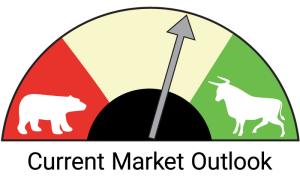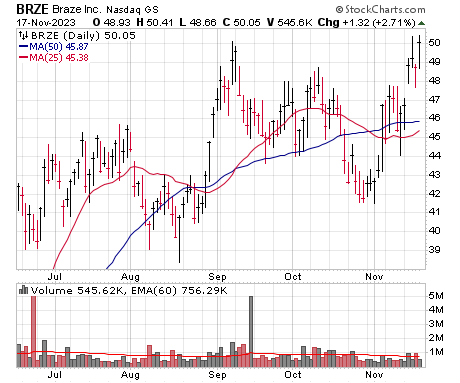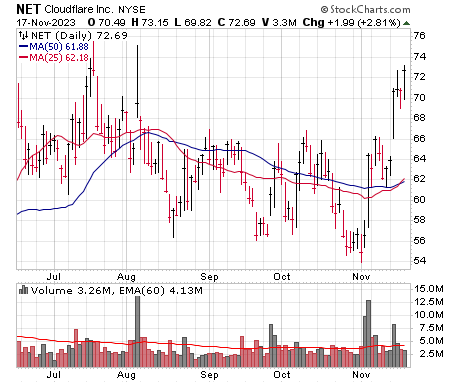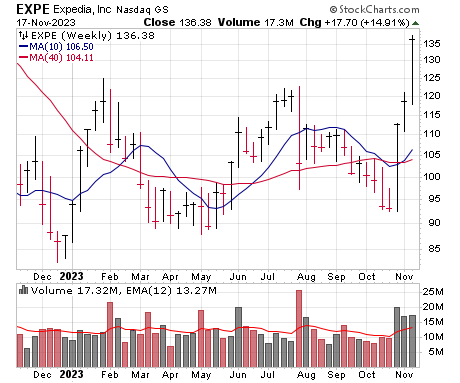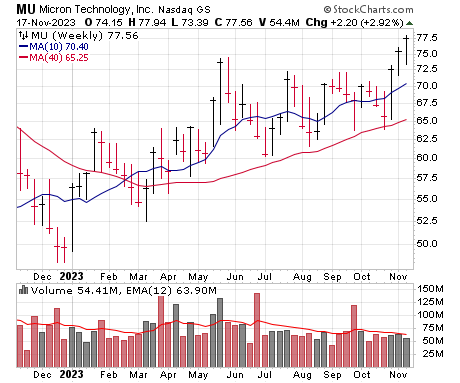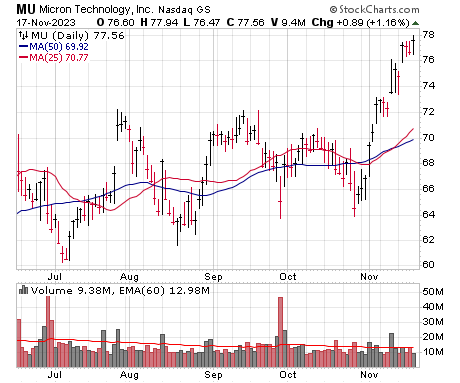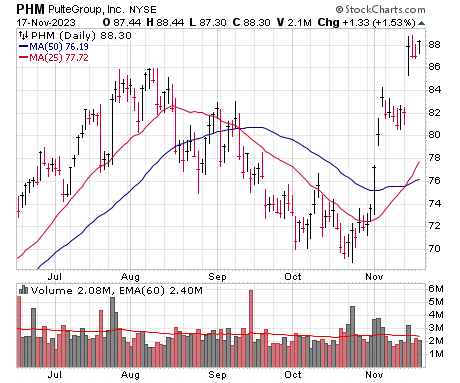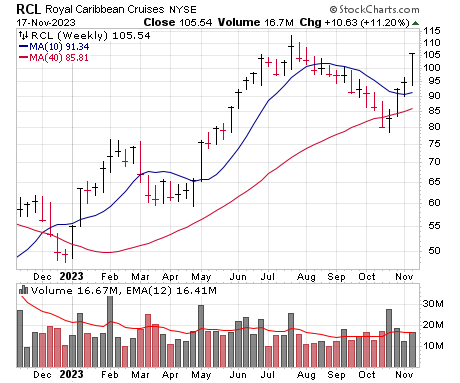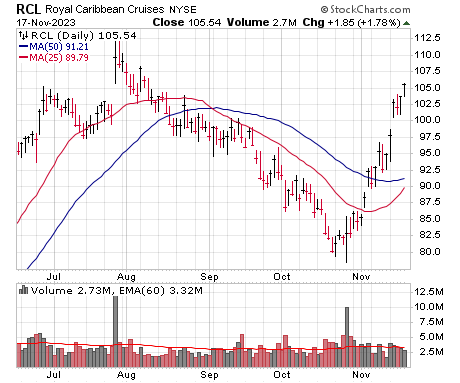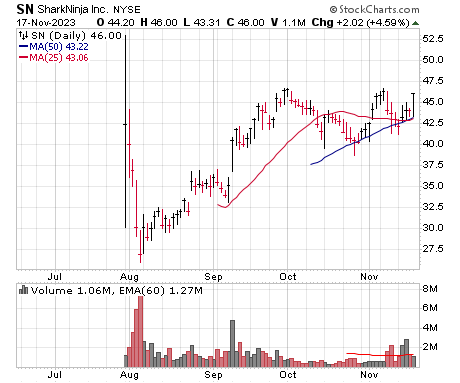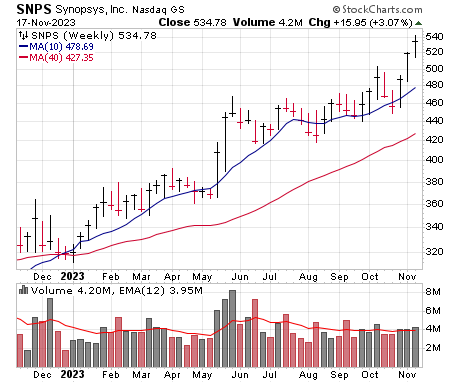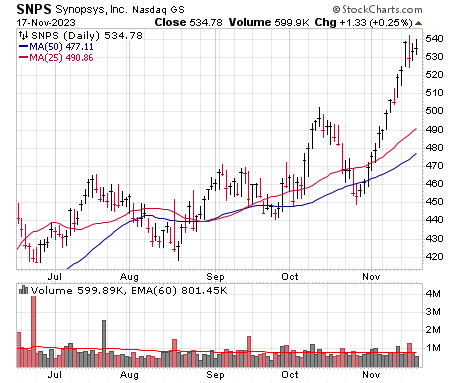Continuing to Improve
There’s no question the market’s evidence continues to improve: The intermediate-term trend has turned up for all of the major indexes, the number of stocks hitting new lows is drying up nicely, individual leading stocks are acting well and, while it’s not a torrent, we are seeing a few more breakouts and setups as the days go by. Once again, it’s not 1999 out there, with wide swaths of the market (and even swaths of growth stocks) still repairing the damage from recent months, so we continue to favor a step-by-step approach when it comes to extending your line, hopping on some strong stocks and, if your portfolio continues to make headway, adding to your positions. We’ll move our Market Monitor up to a level 6 and will continue to raise it should the rally continue to gain steam—possibly quickly if we see a rash of breakouts going ahead.
This week’s list has another crop of super-strong charts, and from a variety of industries, too. Our Top Pick is Pulte Homes (PHM), which isn’t a lightning-fast mover, but it looks like the leader in a group that’s showed exceptional strength off the lows and has a history of trending when conditions are favorable.
Price |
| Braze (BRZE) |
| Cloudflare (NET) |
| Expedia (EXPE) |
| Gap Inc. (GPS) |
| KLA Corp (KLAC) |
| Micron Technology (MU) |
| PulteGroup (PHM) ★ Top Pick ★ |
| Royal Caribbean (RCL) |
| SharkNinja (SN) |
| Synopsys (SNPS) |
Stock 1
Braze (BRZE)
Price |
Why the Strength
First-party data—that is, info a company collects directly from its customers used for marketing purposes—is being widely hailed as the future driver of e-commerce and retail sales. A leading facilitator of first-party data collection is New York-based Braze, which provides a cloud-based customer engagement platform used by mid-to-large-sized businesses for multi-channel marketing to attract and onboard new customers. Its software-as-a-service (SaaS) offerings combine messaging, audience segmentation, analytics, user support in a single integrated solution; the big advantage here is that the firm’s offering works across channels, so a client’s email, text, notifications, WhatsApp messages and other efforts are all working together. (That’s one reason why its client list is chock-full of big consumer-facing brads.) Braze is a fairly young company (founded in 2011) and isn’t yet profitable, but its latest results suggest the firm is well on its way to the black. What’s more, a major investment bank just named Braze as a potential acquisition target in the wake of the Cisco-Splunk deal, while another institution just upgraded the shares based on the company’s “resilient growth” (reasons for the stock’s strength). In Q2, Braze achieved sales of $115 million, a 34% increase from the year-ago quarter, while the per-share loss of four cents beat estimates by 10 cents. Its customer base increased to nearly 2,000 as of July 31 (a 22% improvement from a year ago), with 173 of those clients producing annualized spend of $500,000 or more (up 31%). The positives didn’t end there, as Braze just unveiled Sage AI, a set of advanced artificial intelligence and machine learning capabilities deeply integrated into the Braze platform, data flows, and execution stack designed to facilitate meaningful interactions with customers. Looking ahead, management guided for revenue of $117 million (up 26% if realized) and expects to achieve profitability by the end of next year. The Q3 report is due out December 6.
Technical Analysis
BRZE spent months bottoming out after a huge post-IPO decline, and the earnings-induced gap up in June was certainly a good sign. Interestingly, in recent months, the stock has been very “under control” given the market environment—shares have etched a couple of brief consolidations, with the 50 area being clear resistance. Now BRZE has poked back up to that resistance area and the RP line tagged new highs today—we’re OK buying a small position here or on dips.
| Market Cap | $4.87B | EPS $ Annual (Dec) | ||
| Forward P/E | N/A | FY 2022 | -0.32 | |
| Current P/E | N/A | FY 2023 | -0.64 | |
| Annual Revenue | $409M | FY 2024e | -0.38 | |
| Profit Margin | N/A | FY 2025e | -0.09 | |
| Qtrly Rev | Qtrly Rev Growth | Qtrly EPS | Qtrly EPS Growth | |
| ($M) | (vs. yr-ago-qtr) | ($) | (vs. yr-ago-qtr) | |
| Latest qtr | 115 | 34% | -0.04 | N/A |
| One qtr ago | 102 | 31% | -0.13 | N/A |
| Two qtrs ago | 98.7 | 40% | -0.14 | N/A |
| Three qtrs ago | 93.1 | 46% | -0.15 | N/A |
Weekly Chart | Daily Chart |
Stock 2
Cloudflare (NET)
Price |
Why the Strength
The macro headwinds that drove companies to rein in software spending last year created a negative ripple effect across the entire info tech space. However, infrastructure provider Cloudflare, while not unaffected (growth is slowing somewhat), has continued to grow rapidly and crank out surging profits. And though economic and geopolitical challenges remain, the company is seeing its artificial intelligence (AI) investments start to pay off in a big way. Indeed, Cloudflare was one of the first major info tech players to foresee the AI revolution and has been preparing (in partnership with Nvidia) for the last six years to have server-less, optimized graphics processing units (GPUs) powering its global network to create “the most widely distributed cloud AI inference platform.” (Cloudflare anticipates the GPUs that AI needs will be rolled out by the end of 2024.) Although it’s still in the early stages, Cloudflare also just rolled out Workers AI, a platform for developing AI apps like chatbots directly on its content delivery network. The company sees inference, which runs live data through a trained AI model, as the biggest AI opportunity and developed Workers AI to benefit from this, and the firm already has a pipeline of customers “interested in putting hundreds of billions of inference tasks on our infrastructure each month.” Cloudflare’s cybersecurity business is also still booming and recent months have witnessed a “significant increase” in “massive” cyberattacks globally, helping the firm win some major new contracts (including a $720,000 contract from a major ad tech firm in Q3). All in all, given the tech destruction Cloudflare’s business remains in great shape: Q3 saw a 32% sales gain (client count up 17%, revenue-per-customer up 16%) as and per-share earnings of 16 cents beat estimates six cents. Analysts see 2024 revenues up 28%, which is likely low.
Technical Analysis
NET fell all the way to 40 in June 2022 (down more than 80% from its peak) and then rallied up to 80 in August of last year—and since then, the stock has been confined to that broad range, with lots of tests on the upper and lower ends. Recent months saw the stock reluctantly retreat, shaking below its 40-week line a month ago, but it’s come on in a big way since then, racing back toward the top of its long range. A near-term wobble is possible, so if you want in, aim for dips.
| Market Cap | $24.3B | EPS $ Annual (Dec) | ||
| Forward P/E | 136 | FY 2021 | -0.05 | |
| Current P/E | 177 | FY 2022 | 0.13 | |
| Annual Revenue | $1.21B | FY 2023e | 0.44 | |
| Profit Margin | 16.5% | FY 2024e | 0.53 | |
| Qtrly Rev | Qtrly Rev Growth | Qtrly EPS | Qtrly EPS Growth | |
| ($M) | (vs. yr-ago-qtr) | ($) | (vs. yr-ago-qtr) | |
| Latest qtr | 336 | 32% | 0.16 | 167% |
| One qtr ago | 309 | 32% | 0.10 | 900% |
| Two qtrs ago | 290 | 37% | 0.08 | 700% |
| Three qtrs ago | 275 | 42% | 0.06 | 500% |
Weekly Chart | Daily Chart |
Stock 3
Expedia (EXPE)
Price |
Why the Strength
Expedia is one of the biggest online travel agencies out there, operating not just its namesake website but also popular platforms like Hotels.com, VRBO, Travelocity, Orbitz, Trivago, Hotwire and more; about 80% of reveues come from lodging, with car rentals, insurance, flights and even cruise-related revenue making up the rest. It’s not a new story, but the stock has turned extremely strong for a few reasons, the first of which is that business is great and getting better—while growth is slowing a bit, Q3 results easily topped estimates ($5.41 per share beat by $1.15) and free cash flow is very strong, totaling around $15 per share in the past three quarters alone. Second, all of that has occurred as the firm has invested in some new areas (its business-to-business segment made up 25% of bookings in Q3 and rose 26% from a year ago) and in its technology (now has one unified loyalty program; all brands have been switched to the same tech stack and back-end system), which (a) should help going forward and (b) with the investments in the past, should allow margins and cash flow to rise. Indeed, the top brass has used a lot of the aforementioned free cash flow to buy back a ton of cheap stock (share count down nearly 9% from a year ago; the stock is 15x trailing earnings after the recent run), and it recently approved a giant new $5 billion buyback authorization. The third and final reason for the strength is that management isn’t the only one that sees value here—activist investor ValueAct disclosed a stake (no one knows the size) in Expedia, which certainly can’t hurt the bull cause.
Technical Analysis
EXPE went over the falls in the middle of 2022 and eventually bottomed more than 60% off its high near the end of last year—but, while there were a couple of promising periods, shares were completely waterlogged for the first 10 months of the year. But the last three weeks is something entirely different—not just up, but up huge to its 18 month price highs on massive volume every week. We’re not chasing it here, but we’re also not expecting a big decline given the overwhelming buying power.
| Market Cap | $19.6B | EPS $ Annual (Dec) | ||
| Forward P/E | 11 | FY 2021 | 1.65 | |
| Current P/E | 14 | FY 2022 | 6.79 | |
| Annual Revenue | $12.6B | FY 2023e | 9.46 | |
| Profit Margin | 19.8% | FY 2024e | 12.34 | |
| Qtrly Rev | Qtrly Rev Growth | Qtrly EPS | Qtrly EPS Growth | |
| ($B) | (vs. yr-ago-qtr) | ($) | (vs. yr-ago-qtr) | |
| Latest qtr | 3.93 | 9% | 5.41 | 34% |
| One qtr ago | 3.36 | 6% | 2.89 | 47% |
| Two qtrs ago | 2.67 | 18% | -0.20 | N/A |
| Three qtrs ago | 2.62 | 15% | 1.26 | 19% |
Weekly Chart | Daily Chart |
Stock 4
Gap Inc. (GPS)
Price |
Why the Strength
Despite overall declines in the U.S. apparel market, Gap is turning heads after gaining market share in what has been a challenging retail environment. The company’s progress was highlighted in last week’s Q3 earnings report that gave shares their best single-day performance in over three years. Although revenue of $3.8 billion was 7% lower from a year ago, it exceeded estimates, while earnings of 59 cents a share beat the consensus by a whopping 39 cents. By segment, Gap brand sales were 15% lower at $887 million, but those sales would have declined just 6% if not for the sale of Gap China and the discontinuation of the Yeezy Gap partnership. The company’s Banana Republic business posted an 11% sales loss, while the Athleta segment saw sales fall 18%, in part due to comparisons with last year’s elevated discount levels. However, Gap has big plans for Athleta going forward, including several new store openings, and believes the brand has “significant growth potential” after reaching the number-five spot for top selling U.S. women’s active wear. As for Banana Republic, management is working to re-position it as a premium lifestyle brand while acquiring new, high-value customers. Encouragingly, both the Old Navy (the number two U.S. apparel brand) and Gap chains increased market share in Q3, driven by strength in the women’s, kids, and baby categories, and more importantly margins expanded, inventories tightened and the top brass was optimistic on both headed into the holiday shopping season. (Analysts further expect Old Navy to be a sales leader going forward as it introduces trendier clothing to its lineup.) Cash flow here is strong and the valuation looks reasonable; Wall Street sees earnings up single digits next year, but given some recent beats, most think that could prove way too conservative.
Technical Analysis
GPS peaked in May 2021 around 35 and then sank like a stone, declining almost non-stop for the next 14 months; it spent months bottoming in the 7 to 8 area before finally turning the corner in May. The initial recovery wasn’t anything to write home about, but GPS started to act great in early October and then catapulted on massive volume last Friday, reaching its highest level since January 2022. We’ve seen some turnaround retail stocks work well, so we’re OK grabbing some shares on weakness.
| Market Cap | $6.53B | EPS $ Annual (Jan) | ||
| Forward P/E | 18 | FY 2022 | 1.44 | |
| Current P/E | 72 | FY 2023 | -0.05 | |
| Annual Revenue | $14.8B | FY 2024e | 1.07 | |
| Profit Margin | 5.9% | FY 2025e | 1.05 | |
| Qtrly Rev | Qtrly Rev Growth | Qtrly EPS | Qtrly EPS Growth | |
| ($B) | (vs. yr-ago-qtr) | ($) | (vs. yr-ago-qtr) | |
| Latest qtr | 3.77 | -7% | 0.59 | -17% |
| One qtr ago | 3.55 | -8% | 0.34 | 325% |
| Two qtrs ago | 3.28 | -6% | 0.01 | N/A |
| Three qtrs ago | 4.24 | -6% | -0.75 | N/A |
Weekly Chart | Daily Chart |
Stock 5
KLA Corp (KLAC)
Price |
Why the Strength
Despite semiconductor demand weakness related to consumer electronics, KLA’s business remained stable thanks to its leading position in essential metrology equipment used by chipmakers to test and inspect wafers for imperfections—and now that there are signs that the sector is starting to turn up (giant foundry Taiwan Semi said just that recently) investors are discounting better times ahead. Probably more important than the sector itself is the booming demand for advanced semiconductors related to the twin trends of artificial intelligence (AI) and electronic vehicles (EVs); experts predict a new spending wave for these types of semiconductors in the coming years, and the more advanced chips required for AI and EVs demand a greater investment in metrology equipment. And now, with the down cycle for consumer electronics demand (smartphones, laptops and the like) showing signs of bottoming out, the firm should have plenty more opportunities. On that score, a major Wall Street institution just placed a buy rating on KLA, adding it to its list of “top year-end ideas” that should benefit from what it sees as a technology boom in 2024. Sentiment aside, a big reason for the stock’s strength was the company’s estimate-beating fiscal Q1 (ending September 30) earnings report. Although revenue of $2.4 billion was 12% lower year-on-year, it beat analysts’ estimates and was at the high end of KLA’s guidance, while cash flow increased 3%. Earnings of $5.74 a share beat estimates by 37 cents, thanks in part to strong demand from China (the company is currently tracking around 30 big projects in that country). Going forward, the top brass warned that China demand could moderate in 2024, but expects memory chip investments will rebound in the back half of the year. Wall Street sees revenues dipping slightly next year, then picking up in 2025. A healthy dividend (1.1% yield) is an added attraction.
Technical Analysis
After bottoming out at 250 last October, KLAC quickly found its mojo and sprinted out of the gate in the final months of 2022, and following a few months of base-building, broke out on the upside in May. That said, the move didn’t get far before the market entered its summer funk; KLAC did hold up well, but essentially marked time for five months with support at 450 being tested numerous times. Now, though, the improved market environment and outlook for the chip sector has the stock letting loose on the upside. We’ll aim to enter on dips, though we’re not expecting a huge retreat.
| Market Cap | $73.9B | EPS $ Annual (Jun) | ||
| Forward P/E | 23 | FY 2022 | 21.15 | |
| Current P/E | 23 | FY 2023 | 25.37 | |
| Annual Revenue | $10.2B | FY 2024e | 23.47 | |
| Profit Margin | 32.8% | FY 2025e | 26.44 | |
| Qtrly Rev | Qtrly Rev Growth | Qtrly EPS | Qtrly EPS Growth | |
| ($B) | (vs. yr-ago-qtr) | ($) | (vs. yr-ago-qtr) | |
| Latest qtr | 2.40 | -12% | 5.74 | -19% |
| One qtr ago | 2.36 | -5% | 5.40 | -7% |
| Two qtrs ago | 2.43 | 6% | 5.49 | 7% |
| Three qtrs ago | 2.98 | 27% | 7.38 | 32% |
Weekly Chart | Daily Chart |
Stock 6
Micron Technology (MU)
Price |
Why the Strength
Micron is a leader in innovative digital memory chips and storage solutions—both of which are heavily used in the white-hot fields of electric and autonomous vehicle (EV and AV) manufacturing. Along with continued strength from cloud computing and data center markets (the current demand drivers), Micron believes AVs will be one of its top demand drivers in the years ahead as cars gradually incorporate more self-driving features in the years ahead. A leading indication of that was the fiscal Q4 (quarter ending August 31) performance, in which Micron achieved record annual automotive revenue, thanks to its “strong” design win trajectory in the EV space. Total Q4 revenue of $4 billion was up 7% from last quarter but down 40% year-on-year, with DRAM sales comprising 70% of the total (up 3% sequentially) and NAND sales 30% (up 19%). The per-share loss of $1.07, meanwhile, beat estimates by 11 cents. While management warned that macro factors are still a risk, it expects “robust” demand growth in 2024 for both DRAM and NAND, driven by improving inventory levels and content growth across products. The firm also expects “accelerating AI-driven opportunities” for memory and storage across multiple market segments—particularly in the industrial sector, which Micron said is showing “promising” signs of recovery. And then there’s the overall chip market supply and demand fundamentals, which are improving, and the top brass sees record chip industry revenue in 2025 as AI proliferates. For next year, the Wall Street consensus see top-line growth of 35% as the loss shrinks, followed by a booming bottom line in late 2024/early 2025.
Technical Analysis
MU started its bear market bottoming process last summer—a few months before many of its industry peers did the same. The bottoming ended as the New Year began, and MU’s rebound was inaugurated when it got back above the 40-week line in March. However, the stock ran into a wall near Memorial Day, etching a reasonable, tightening sideways range for the past many months, and since testing the 200-day line in October, MU has changed character, bursting to new 19-month price highs. If you want in, you can buy some here or (preferably) on dips of a couple of points.
| Market Cap | $85.2B | EPS $ Annual (Dec) | ||
| Forward P/E | N/A | FY 2021 | 8.34 | |
| Current P/E | N/A | FY 2022 | -4.45 | |
| Annual Revenue | $15.5B | FY 2023e | -2.10 | |
| Profit Margin | N/A | FY 2024e | 4.02 | |
| Qtrly Rev | Qtrly Rev Growth | Qtrly EPS | Qtrly EPS Growth | |
| ($B) | (vs. yr-ago-qtr) | ($) | (vs. yr-ago-qtr) | |
| Latest qtr | 4.01 | -40% | -1.07 | N/A |
| One qtr ago | 3.75 | -57% | -1.43 | N/A |
| Two qtrs ago | 3.69 | -53% | -1.91 | N/A |
| Three qtrs ago | 4.09 | -47% | -0.04 | N/A |
Weekly Chart | Daily Chart |
Stock 7
PulteGroup (PHM) ★ Top Pick ★
Price |
Why the Strength
We don’t remember anyone expecting housing prices to remain elevated despite a five percentage point hike in mortgage rates, but ironically, that’s exactly what’s happened—and when combined with what is now more than a decade of under-building (housing starts were higher decades ago despite a smaller population) and rates that are now easing a bit, and the setup is there for homebuilders to see their already-elevated earnings totals grow further. Pulte is one of the big dogs of the group, operating across the U.S. for just about every segment, from first-timers (38% of homes closed in Q3) to move-ups (37%) to active adult communities (25%, including many cash buyers), and at a variety of price points as well. Amazingly, sales and earnings have been cranking ahead every quarter, and while growth has slowed of late (Q3 sales and earnings up single digits), the Q3 report had a lot of positives, including 43% increase in unit orders (up 36% in value) from a year ago, while gross margins reached 29.5% (best in the industry according to management). To be fair, nearly 40% of homes under construction right now are on spec, so if for some reason the sector hit the skids (say, if the job market really keeled over for whatever reason), there’s downside potential here. But the top brass has pulled back a good amount in recent quarters given the industry fears, and if anything, it’s more likely continued surprises on the upside will come—in February, analysts saw earnings of around $7 per share this year and next, well below today’s $11-plus outlook, and that figure could easily go higher.
Technical Analysis
PHM and other builders had surprising runs earlier this year despite higher interest rates, though the fun times ended in August as rate fears and a weak market brought in the sellers. Even so, the dip wasn’t harsh compared to the spring/summer advance, with PHM dipping “only” 20% and finding support just under 70 (and just over its 200-day line). And now we see lots of signs big investors are piling in—shares found support on earnings near the lows and have gapped up strongly three times on big volume, with the stock notching new price and RP peaks last week. It’s aggressive, but we’re OK picking up a position here or on pullbacks.
| Market Cap | $19.0B | EPS $ Annual (Dec) | ||
| Forward P/E | 8 | FY 2021 | 7.36 | |
| Current P/E | 7 | FY 2022 | 10.88 | |
| Annual Revenue | $16.9B | FY 2023e | 11.51 | |
| Profit Margin | 16.0% | FY 2024e | 11.25 | |
| Qtrly Rev | Qtrly Rev Growth | Qtrly EPS | Qtrly EPS Growth | |
| ($B) | (vs. yr-ago-qtr) | ($) | (vs. yr-ago-qtr) | |
| Latest qtr | 4.00 | 3% | 2.90 | 8% |
| One qtr ago | 4.19 | 8% | 3.21 | 18% |
| Two qtrs ago | 3.58 | 14% | 2.35 | 28% |
| Three qtrs ago | 5.17 | 19% | 3.63 | 45% |
Weekly Chart | Daily Chart |
Stock 8
Royal Caribbean (RCL)
Price |
Why the Strength
Like a lot of cyclical names, investors have been thinking the monetary tightening and other world problems would eventually crimp the outlook for Royal Caribbean, but quarter by quarter, the firm’s outstanding, estimate-beating results are turning big investors into believers. The company one of the largest cruise ship operators with 64 ships under three different brands (Royal Caribbean, Celebrity, Silversea) that sail to around 1,000 different locations, and the stock is strong today because business has been booming and there’s no sign of that slowing. In Q3, the company again topped expectations, with sales up 39% and earnings of $3.85 per share beating by 39 cents, and even more impressive were many of the sub-metrics: Revenue per passenger day was up nearly 18% compared to 2019, while gross EBITDA margins are nuts (41.5%) as all of the revenue increases are falling to the bottom line and the load factor reached 110%. More important for investors is the future, with Q3 bookings significantly ahead of Q3 2019 levels and “demand for 2024 has continued to accelerate, with bookings significantly and consistently outpacing 2019 levels. Booked load factors and rates are higher than all prior years while the booking window has continued to extend.” Royal is also expanding, with three new ship deliveries (including the Celebrity Ascent, which has gotten some hubbub) that are seeing strong bookings, too. By 2025, the top brass has a goal of $10-plus of EPS, which is already looking conservative given Wall Street’s view of $9 per share next year.
Technical Analysis
RCL had its first fresh breakout of this upcycle in early May when the stock reacted well on earnings—the ensuing run took the stock all the way to 113 (after another positive earnings reaction) before the market pulled the stock lower and lower, with a mini-shakeout under the 200-day line. But RCL has acted like a homesick angel since, with a straight-up move over the past four weeks, kicked off by yet another supportive earnings reaction. Dips toward the century mark would be tempting.
| Market Cap | $27.0B | EPS $ Annual (Dec) | ||
| Forward P/E | 16 | FY 2021 | -19.19 | |
| Current P/E | 24 | FY 2022 | -7.50 | |
| Annual Revenue | $13.2B | FY 2023e | 6.52 | |
| Profit Margin | 25.6% | FY 2024e | 8.97 | |
| Qtrly Rev | Qtrly Rev Growth | Qtrly EPS | Qtrly EPS Growth | |
| ($B) | (vs. yr-ago-qtr) | ($) | (vs. yr-ago-qtr) | |
| Latest qtr | 4.16 | 39% | 3.85 | N/A |
| One qtr ago | 3.52 | 61% | 1.82 | N/A |
| Two qtrs ago | 2.89 | 172% | -0.23 | N/A |
| Three qtrs ago | 2.60 | 165% | -1.12 | N/A |
Weekly Chart | Daily Chart |
Stock 9
SharkNinja (SN)
Price |
Why the Strength
SharkNinja makes household electronics under two brands, Shark and Ninja. Ninja is the slightly larger of the two, accounting for 55% of sales, focusing mainly on food-related small appliances like air fryers and waffle makers as well as cookware, bakeware and cutlery. Shark is the brand for the rest of the home, having had lots of success with a variety of vacuums, mops, air purifiers and hair stylers. Management has been grabbing market share from more established brands through a combination of aggressive multichannel marketing – TV commercials, social media influencers and plentiful media stories – along with being channel agnostic, not relying on one retailer or channel to sell products; it sells direct to consumer, through web retailers and a diverse slate of brick-and-mortar stores, from Lowe’s to Sephora. SharkNinja is in 27 subcategories and seeks to expand into new ones constantly when it can put a spin on an established appliance, enabling it to charge a premium but not so much that it would have to compete with luxury brands. It recently rolled out a series of small outdoor smokers/grills, for instance, that use wood pellets instead of propane, small enough for city dwellers to use on a balcony. The company also jumped into the at-home carbonated drink segment, garnering its Ninja Thirsti line lots of attention on TikTok and Instagram. It’s tough to pin down what, exactly, SharkNinja’s secret sauce is besides tons of R&D and customer feedback, but it’s working wonders. Sales should exceed $4 billion this year, up more than 10% from last year, with earnings of $3.13 per share, making it one of the most profitable operations in the space. Beyond adding new products, SharkNinja can grow by looking outside North America, which is 80% of sales today.
Technical Analysis
SN was spun off on the last day of July and saw some huge volatility in the sessions that followed. But after a short, sharp dip, the stock found its footing and enjoyed a fairly persistent run to 47 at the end of September. The action since then has been choppy, but given the market’s weakness, has been more than acceptable, and now SN is taking aim at new closing highs. We’ll set our buy range up from here, getting in on a breakout from the recent range.
| Market Cap | $6.39B | EPS $ Annual (Dec) | ||
| Forward P/E | 14 | FY 2021 | 3.05 | |
| Current P/E | 16 | FY 2022 | 2.38 | |
| Annual Revenue | $4.06B | FY 2023e | 3.13 | |
| Profit Margin | 12.4% | FY 2024e | 3.31 | |
| Qtrly Rev | Qtrly Rev Growth | Qtrly EPS | Qtrly EPS Growth | |
| ($M) | (vs. yr-ago-qtr) | ($) | (vs. yr-ago-qtr) | |
| Latest qtr | 1070 | 13% | 0.96 | 35% |
| One qtr ago | 950 | 22% | 0.47 | 42% |
| Two qtrs ago | 855 | 6% | 0.86 | 9% |
| Three qtrs ago | 1183 | 27% | 0.54 | -29% |
Weekly Chart | Daily Chart |
Stock 10
Synopsys (SNPS)
Price |
Why the Strength
Synopsis produces electronic design automation software (EDA) and chip design intellectual property (IP), which microchip makers use to test and design their products; the two business lines account for 90% of Synopsis’ $5.53 billion of revenue over the past year, so these are clearly the drivers. And the market is as big as it gets: Any firm that makes a chip for mobile, data center, PC or any other application needs EDA tools and IP, in part to ensure their products use all the correct protocols to connect to other devices and networks. Because there are so many variables in the world of advanced chip design, the industry has consolidated in recent years, leaving Synopsis as the largest player, with about one-third market share. The complexity of the business also means there’s not much likelihood of upstart competitors, which keeps margins elevated (and big investors interested). The balance of Synopsis’ business is software integrity, which is a complementary service to EDA and IP. Looking ahead, two newer trends are helping Synopsis now: The electrification of large sectors like automobiles and energy, which expands the need for chip design, as well as AI, where chip designers are increasingly licensing Synopsis EDA and IP to speed their development of AI chips to capture exploding end-market demand. The profitability of its AI products means the company should add a full two percentage points to its gross margin for 2023. The quarter that ended Halloween (report due November 29) should see a 23% rise in sales over last year to $1.58 billion with a 60% jump in net income to $3.03 a per share. Revenue can be a bit lumpy, since demand for Synopsis IP of specific blocks as a basis for chip design depends on customers’ development speed, but management says once a customer starts using their block IP, they’re essentially locked in to using Synopsis for life. Analysts see 20% earnings growth in 2024, which is likely low.
Technical Analysis
SNPS broke out of a two-year range in May, bursting to 468 within a few days—but then it bobbed and weaved for the next few months, with slightly higher highs and higher lows, but net-net, shares did nothing for five months. But after the last dip to 450, it now looks like the sellers have run out of ammo, with SNPS enjoying a beautiful, persistent romp to new highs. Given the move and upcoming earnings, we’ll set our entry range down a bit.
| Market Cap | $81.3B | EPS $ Annual (Oct) | ||
| Forward P/E | 48 | FY 2021 | 6.84 | |
| Current P/E | 54 | FY 2022 | 8.90 | |
| Annual Revenue | $5.52B | FY 2023e | 11.20 | |
| Profit Margin | 30.0% | FY 2024e | 13.43 | |
| Qtrly Rev | Qtrly Rev Growth | Qtrly EPS | Qtrly EPS Growth | |
| ($B) | (vs. yr-ago-qtr) | ($) | (vs. yr-ago-qtr) | |
| Latest qtr | 1.49 | 19% | 2.88 | 37% |
| One qtr ago | 1.39 | 9% | 2.54 | 2% |
| Two qtrs ago | 1.36 | 7% | 2.62 | 9% |
| Three qtrs ago | 1.28 | 11% | 1.91 | 5% |
Weekly Chart | Daily Chart |
Previously Recommended Stocks
| Date | Stock | Symbol | Top Pick | Original Buy Range | 11/20/23 |
| HOLD | |||||
| 10/23/23 | 555-570 | 613 | |||
| 10/23/23 | 94.5-96.5 | 103 | |||
| 10/16/23 | 214-218 | 226 | |||
| 10/16/23 | 77-79 | 78 | |||
| 11/6/23 | 40-41.5 | 45 | |||
| 11/6/23 | 180-184 | 194 | |||
| 9/5/23 | ★ | 161-166 | 208 | ||
| 9/18/23 | ★ | 66-68 | 73 | ||
| 11/6/23 | 86.5-89 | 96 | |||
| 11/6/23 | ★ | 33-35 | 39 | ||
| 11/13/23 | Duolingo | DUOL | 202-208 | 216 | |
| 10/16/23 | ★ | 595-608 | 598 | ||
| 10/30/23 | 207-211 | 222 | |||
| 10/23/23 | 73.5-76 | 86 | |||
| 11/6/23 | 433-445 | 455 | |||
| 10/16/23 | 27-28 | 28 | |||
| 7/10/23 | ★ | 45-47 | 46 | ||
| 9/5/23 | ★ | 33-34.5 | 40 | ||
| 2/27/23 | 225-230 | 504 | |||
| 10/30/23 | 79.5-81 | 78 | |||
| 10/23/23 | 16.5-17.5 | 21 | |||
| 10/23/23 | 16-16.5 | 16 | |||
| 11/6/23 | 29.5-31 | 32 | |||
| 10/9/23 | 33-34 | 33 | |||
| 10/30/23 | 166-169 | 180 | |||
| 11/6/23 | 77-79 | 86 | |||
| 10/30/23 | 87.5-89.5 | 93 | |||
| 5/8/23 | 37-39 | 55 | |||
| 10/2/23 | 71-73.5 | 88 | |||
| 10/2/23 | Zscaler | ZS | 165-170 | 192 | |
| WAIT | |||||
| 11/13/23 | 44-45.5 | 40 | |||
| 11/13/23 | 100-103 | 112 | |||
| 11/13/23 | 86-88.5 | 93 | |||
| 11/13/23 | 383-390 | 407 | |||
| 11/13/23 | ★ | 624-640 | 667 | ||
| 11/13/23 | WW Grainger | GWW | 770-785 | 809 | |
| SELL | |||||
| 10/23/23 | 16.7-17.4 | 20 | |||
| 10/23/23 | 59-61 | 71 | |||
| 10/23/23 | 54-56 | 56 | |||
| 9/25/23 | TechnipFTI | FTI | 19.8-20.6 | 21 | |
| DROPPED | |||||
| 11/6/23 | 111-114 | 120 | |||
| 11/6/23 | 198-204 | 232 | |||
The next Cabot Top Ten Trader issue will be published on December 4, 2023.
